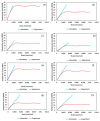Effect of Unit Cell Type and Pore Size on Porosity and Mechanical Behavior of Additively Manufactured Ti6Al4V Scaffolds
- PMID: 30487419
- PMCID: PMC6317238
- DOI: 10.3390/ma11122402
Effect of Unit Cell Type and Pore Size on Porosity and Mechanical Behavior of Additively Manufactured Ti6Al4V Scaffolds
Abstract
Porous metal structures have emerged as a promising solution in repairing and replacing damaged bone in biomedical applications. With the advent of additive manufacturing technology, fabrication of porous scaffold architecture of different unit cell types with desired parameters can replicate the biomechanical properties of the natural bone, thereby overcoming the issues, such as stress shielding effect, to avoid implant failure. The purpose of this research was to investigate the influence of cube and gyroid unit cell types, with pore size ranging from 300 to 600 µm, on porosity and mechanical behavior of titanium alloy (Ti6Al4V) scaffolds. Scaffold samples were modeled and analyzed using finite element analysis (FEA) following the ISO standard (ISO 13314). Selective laser melting (SLM) process was used to manufacture five samples of each type. Morphological characterization of samples was performed through micro CT Scan system and the samples were later subjected to compression testing to assess the mechanical behavior of scaffolds. Numerical and experimental analysis of samples show porosity greater than 50% for all types, which is in agreement with desired porosity range of natural bone. Mechanical properties of samples depict that values of elastic modulus and yield strength decreases with increase in porosity, with elastic modulus reduced up to 3 GPa and yield strength decreased to 7 MPa. However, while comparing with natural bone properties, only cube and gyroid structure with pore size 300 µm falls under the category of giving similar properties to that of natural bone. Analysis of porous scaffolds show promising results for application in orthopedic implants. Application of optimum scaffold structures to implants can reduce the premature failure of implants and increase the reliability of prosthetics.
Keywords: Ti6Al4V; Young’s modulus; cube; gyroid; porous; selective laser melting; stress shielding effect.
Conflict of interest statement
The authors declare no conflict of interest.
Figures












Similar articles
-
Fatigue behavior of As-built selective laser melted titanium scaffolds with sheet-based gyroid microarchitecture for bone tissue engineering.Acta Biomater. 2019 Aug;94:610-626. doi: 10.1016/j.actbio.2019.05.046. Epub 2019 May 22. Acta Biomater. 2019. PMID: 31125727
-
Bionic mechanical design and 3D printing of novel porous Ti6Al4V implants for biomedical applications.J Zhejiang Univ Sci B. 2019 Aug.;20(8):647-659. doi: 10.1631/jzus.B1800622. J Zhejiang Univ Sci B. 2019. PMID: 31273962 Free PMC article.
-
Topological design, permeability and mechanical behavior of additively manufactured functionally graded porous metallic biomaterials.Acta Biomater. 2019 Jan 15;84:437-452. doi: 10.1016/j.actbio.2018.12.013. Epub 2018 Dec 8. Acta Biomater. 2019. PMID: 30537537
-
Development of Bioactive Scaffolds for Orthopedic Applications by Designing Additively Manufactured Titanium Porous Structures: A Critical Review.Biomimetics (Basel). 2023 Nov 13;8(7):546. doi: 10.3390/biomimetics8070546. Biomimetics (Basel). 2023. PMID: 37999187 Free PMC article. Review.
-
Exploring Macroporosity of Additively Manufactured Titanium Metamaterials for Bone Regeneration with Quality by Design: A Systematic Literature Review.Materials (Basel). 2020 Oct 27;13(21):4794. doi: 10.3390/ma13214794. Materials (Basel). 2020. PMID: 33121025 Free PMC article. Review.
Cited by
-
Computational Design and Characterisation of Gyroid Structures with Different Gradient Functions for Porosity Adjustment.Materials (Basel). 2022 May 23;15(10):3730. doi: 10.3390/ma15103730. Materials (Basel). 2022. PMID: 35629755 Free PMC article.
-
TPMS Microarchitectures for Vertical Bone Augmentation and Osteoconduction: An In Vivo Study.Materials (Basel). 2024 May 24;17(11):2533. doi: 10.3390/ma17112533. Materials (Basel). 2024. PMID: 38893806 Free PMC article.
-
Definition, measurement, and function of pore structure dimensions of bioengineered porous bone tissue materials based on additive manufacturing: A review.Front Bioeng Biotechnol. 2023 Jan 4;10:1081548. doi: 10.3389/fbioe.2022.1081548. eCollection 2022. Front Bioeng Biotechnol. 2023. PMID: 36686223 Free PMC article. Review.
-
Application of Computational Method in Designing a Unit Cell of Bone Tissue Engineering Scaffold: A Review.Polymers (Basel). 2021 May 14;13(10):1584. doi: 10.3390/polym13101584. Polymers (Basel). 2021. PMID: 34069101 Free PMC article. Review.
-
[Effect of porous zirconia ceramics on proliferation and differentiation of osteoblasts].Beijing Da Xue Xue Bao Yi Xue Ban. 2022 Feb 18;54(1):31-39. doi: 10.19723/j.issn.1671-167X.2022.01.006. Beijing Da Xue Xue Bao Yi Xue Ban. 2022. PMID: 35165465 Free PMC article. Chinese.
References
-
- Kim T.B., Yue S., Zhang Z., Jones E., Jones J.R., Lee P.D. Additive manufactured porous titanium structures: Through-process quantification of pore and strut networks. J. Mater. Process. Technol. 2014;214:2706–2715. doi: 10.1016/j.jmatprotec.2014.05.006. - DOI
-
- Arabnejad S., Johnston R.B., Pura J.A., Singh B., Tanzer M., Pasini D. High-strength porous biomaterials for bone replacement: A strategy to assess the interplay between cell morphology, mechanical properties, bone ingrowth and manufacturing constraints. Acta Biomater. 2016;30:345–356. doi: 10.1016/j.actbio.2015.10.048. - DOI - PubMed
-
- Hayes J.S., Czekanska E.M., Richards R.G. In: Tissue Engineering III: Cell—Surface Interactions for Tissue Culture. Kasper C., Witte F., Pörtner R., editors. Springer; Berlin/Heidelberg, Germany: 2012.
-
- Mullen L., Stamp R.C., Brooks W.K., Jones E., Sutcliffe C.J. Selective laser melting: A regular unit cell approach for the manufacture of porous, titanium, bone in-growth constructs, suitable for orthopedic applications. J. Biomed. Mater. Res. 2009;89:325–334. doi: 10.1002/jbm.b.31219. - DOI - PubMed
Grants and funding
LinkOut - more resources
Full Text Sources
Other Literature Sources

